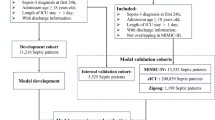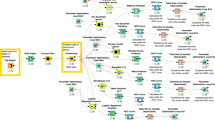Abstract
The high availability of clinical data and a heterogeneous and complex patient population makes Intensive Care Units (ICUs) environments opportune for developing a system that analyzes large amounts of raw data, which human specialists can neglect. Quantifying a patient’s condition to support the definition and adjustment of clinical treatment and predict future outcomes is a significant research problem in intensive care. This work’s main objective is to conceive an approach to predicting ICUs mortality risk. Therefore, the designed approach is a binary classification task that aims to predict whether patients will die or survive during their ICU stay. A cohort of 17,734 patients was used from the MIMIC-III database, considering 10 input predictor variables and 8 Machine Learning methods. Sensitivity, specificity, F1 score, AUC, and ROC curve are used to compare different models of mortality risk prediction in a 48-h window of data acquisition. The best performance was achieved by the Gradient Boosting Machine (GBM) method, which obtained 0,843 (±0,015) of AUC and 0,503 (±0,048) for the F1 score. The approach conceived enables the generation of robust models capable of detecting hidden patterns and having greater power of discrimination in classifications. The results are promising and, in some cases, superior to those obtained by other proposals identified in the literature review.
Supported by CAPES, CNPq and IF-RS.
Access this chapter
Tax calculation will be finalised at checkout
Purchases are for personal use only
Similar content being viewed by others
References
Alghatani, K., Ammar, N., Rezgui, A., Shaban-Nejad, A.: Predicting intensive care unit length of stay and mortality using patient vital signs: machine learning model development and validation (2021). https://doi.org/10.2196/21347
Awad, A., Bader-El-Den, M., McNicholas, J., Briggs, J., El-Sonbaty, Y.: Predicting hospital mortality for intensive care unit patients: time-series analysis. Health Inf. J. 26(2), 1043–1059 (2020). https://doi.org/10.1177/1460458219850323, http://journals.sagepub.com/doi/10.1177/1460458219850323
Baker, S., Xiang, W., Atkinson, I.: Continuous and automatic mortality risk prediction using vital signs in the intensive care unit: a hybrid neural network approach (2020). https://doi.org/10.1038/s41598-020-78184-7
Barella, V.H., Garcia, L.P.F., de Carvalho, A.C.P.L.F.: Simulating complexity measures on imbalanced datasets. In: 9th Brazilian Conference on Intelligent Systems (BRACIS) (2020)
Bergstra, J., Bengio, Y.: Random search for hyper-parameter optimization. J. Mach. Learn. Res. 13, 281–305 (2012)
Bhattacharya, S., Rajan, V., Shrivastava, H.: ICU mortality prediction: a classification algorithm for imbalanced datasets (2017)
Bosco, A.D., Vieira, R., Zanotto, B., da Silva Etges, A.P.B.: Ontology based classification of electronic health records to support value-based health care. In: 10th Brazilian Conference on Intelligent Systems (BRACIS) (2021)
Bradley, A.P.: The use of the area under the ROC curve in the evaluation of machine learning algorithms. Patt. Recogn. 30(7), 1145–1159 (1997). https://doi.org/10.1016/S0031-3203(96)00142-2
Cagnini, H.E.L., Freitas, A.A., Barros, R.C.: An evolutionary algorithm for learning interpretable ensembles of classifiers. In: 9th Brazilian Conference on Intelligent Systems (BRACIS) (2020)
Churpek, M.M., Yuen, T.C., Winslow, C., Meltzer, D.O., Kattan, M.W., Edelson, D.P.: Multicenter comparison of machine learning methods and conventional regression for predicting clinical deterioration on the wards. Critical Care Med. 44(2), 368–374 (2016). https://doi.org/10.1097/CCM.0000000000001571, http://journals.lww.com/00003246-201602000-00016
Faceli, K., Lorena, A.C., Gama, J., de Carvalho, A.C.P.d.L.F., de Almeida, T.A.: Inteligência Artificial - Uma Abordagem de Aprendizado de Máquina. 2a edição edn (2021)
Harutyunyan, H., Khachatrian, H., Kale, D.C., Ver Steeg, G., Galstyan, A.: Multitask learning and benchmarking with clinical time series data. Sci. Data 6(1) (2019). https://doi.org/10.1038/s41597-019-0103-9
Johnson, A.E.W., Dunkley, N., Mayaud, L., Tsanas, A., Kramer, A.A., Clifford, D.: Patient Specific Predictions in the Intensive Care Unit Using a Bayesian Ensemble (Mimic), pp. 249–252 (2012)
Johnson, A.E., et al.: MIMIC-III, a freely accessible critical care database. Sci. Data 3(1), 160035 (2016). https://doi.org/10.1038/sdata.2016.35, http://www.nature.com/articles/sdata201635
Liu, J., et al.: Mortality prediction based on imbalanced high-dimensional ICU big data. Comput. Indust. 98, 218–225 (2018). https://doi.org/10.1016/j.compind.2018.01.017, https://linkinghub.elsevier.com/retrieve/pii/S0166361517304505
Machado, R.d.S., Almeida, R.B., da Rosa, D.Y.L., Lopes, J.L.B., Pernas, A.M., Yamin, A.C.: EXEHDA-HM: a compositional approach to explore contextual information on hybrid models. Future Gener. Comput. Syst. 73, 1–12 (2017). https://doi.org/10.1016/j.future.2017.03.005, https://doi.org/10.1016/j.future.2017.03.005
Muralitharan, S., et al.: Machine learning-based early warning systems for clinical deterioration: systematic scoping review. J. Med. Internet Res. 23(2) (2021). https://doi.org/10.2196/25187
Pirracchio, R., Petersen, M.L., Carone, M., Rigon, M.R., Chevret, S., van der Laan, M.J.: Mortality prediction in intensive care units with the Super ICU Learner Algorithm (SICULA): a population-based study. Lancet Respiratory Med. 3(1), 42–52 (2015). https://doi.org/10.1016/S2213-2600(14)70239-5, https://linkinghub.elsevier.com/retrieve/pii/S2213260014702395
Purushotham, S., Meng, C., Che, Z., Liu, Y.: Benchmarking deep learning models on large healthcare datasets (2018). https://doi.org/10.1016/j.jbi.2018.04.007, https://www.sciencedirect.com/science/article/pii/S1532046418300716
Segato, T.H.F., Serafim, R.M.d.S., Fernandes, S.E.S., Ralha, C.G.: Mas4gc: multi-agent system for glycemic control of intensive care unit patients. In: 10th Brazilian Conference on Intelligent Systems (BRACIS) (2021)
Zhu, Y., Fan, X., Wu, J., Liu, X., Shi, J., Wang, C.: Predicting ICU mortality by supervised bidirectional LSTM networks (2018). http://ceur-ws.org/Vol-2142/paper4.pdf
Acknowledgments
The present work was supported by Conselho Nacional de Desenvolvimento Científico e Tecnológico (CNPq), Coordenação de Aperfeiçoamento de Pessoal de Nível Superior - Brazil (CAPES) - Financing Code 001 and Instituto Federal do Rio Grande do Sul (IF-RS).
Author information
Authors and Affiliations
Corresponding author
Editor information
Editors and Affiliations
Rights and permissions
Copyright information
© 2022 The Author(s), under exclusive license to Springer Nature Switzerland AG
About this paper
Cite this paper
de Souza, A.R.R. et al. (2022). Mortality Risk Evaluation: A Proposal for Intensive Care Units Patients Exploring Machine Learning Methods. In: Xavier-Junior, J.C., Rios, R.A. (eds) Intelligent Systems. BRACIS 2022. Lecture Notes in Computer Science(), vol 13653. Springer, Cham. https://doi.org/10.1007/978-3-031-21686-2_1
Download citation
DOI: https://doi.org/10.1007/978-3-031-21686-2_1
Published:
Publisher Name: Springer, Cham
Print ISBN: 978-3-031-21685-5
Online ISBN: 978-3-031-21686-2
eBook Packages: Computer ScienceComputer Science (R0)




